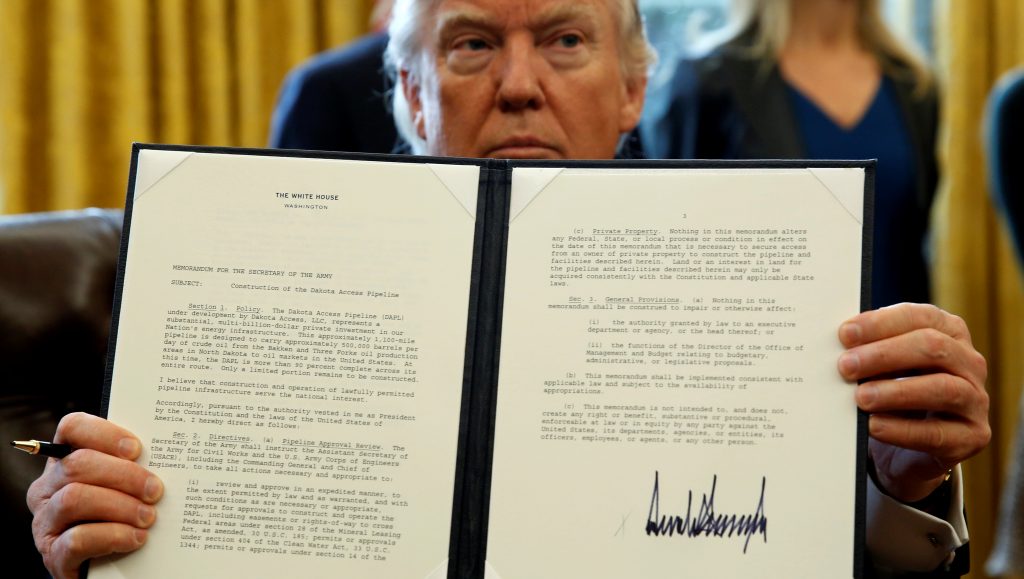On his first day back in office, President Donald Trump is poised to sign approximately 200 executive orders aimed at reshaping various federal policies. These actions focus on dismantling diversity, equity, and inclusion programs, emphasizing a strict definition of two sexes, and reinforcing security at the border. This sweeping agenda signifies Trump’s commitment to rapidly implementing changes that align with his campaign promises.
Following his inauguration, Trump conducted a series of executive signings at both Capitol Hill and before supporters at Capital One Arena. Among the initial actions was the revocation of 78 executive orders previously instituted by former President Joe Biden. As Trump proceeds with this aggressive policy shift, he is expected to encounter significant legal challenges.
Key Takeaways
- Trump plans to sign 200 executive orders focusing on various issues.
- Many policies may face legal opposition.
- Revocation of Biden’s prior orders marks a significant policy shift.
Border-related executive orders
The recent executive orders issued by the administration have set out a series of actions focused on border security and immigration control. These orders signify a comprehensive approach to addressing long-standing concerns related to the southern border and immigration policies.
One of the key orders declares a national emergency at the southern border. This move is designed to enable the secretary of defense to swiftly deploy armed forces as needed and allocate additional federal resources to bolster border security efforts.
Ending the controversial “catch and release” program is another pivotal measure. This program allowed immigrants who entered the country illegally to remain in the United States while awaiting asylum hearings. By terminating this policy, the administration aims to deter illegal crossings and reinforce legal immigration channels. Border czar Tim Homan emphasized the importance of immigrants remaining in their home countries during the asylum process.
The renewal of the Remain in Mexico policy, officially known as the Migration Protection Protocols, is another significant action. Previously implemented during the president’s first term, this policy requires asylum seekers to wait in Mexico until their claims are processed. While the Biden administration ended this policy in 2022, the new order seeks to reinstate it, doubling down on the need to handle asylum applications outside U.S. borders.
Resumption of border wall construction marks another point of focus. Originally initiated during Trump’s previous tenure, the continuation of the wall aims to further curb illegal entries and reinforce physical barriers along the southern border.
The designation of Mexico’s drug cartels as global terrorist organizations signals a strong stance on tackling cross-border drug trafficking. This action intends to enhance international collaboration and apply more severe measures against these organizations.
Suspending refugee resettlement for a period of four months highlights a shift in the administration’s approach to managing refugee admissions. This suspension aligns with efforts to curb what is perceived as a migrant influx into the United States, prioritizing national security and streamlined legal entry processes.
Furthermore, an order attempts to redefine birthright citizenship. By challenging the 14th Amendment’s guarantee, the administration seeks to provoke legal debates regarding citizenship rights granted by birth within the country.
An additional directive prioritizes military involvement at borders, tasking the military with upholding the nation’s territorial integrity and emphasizing their role in border operations. This includes constructing barriers and deploying technological surveillance like drones to enhance security measures.
Finally, an order aimed at enhancing border vetting and screening procedures highlights an intensified scrutiny over migrants seeking entry into the United States, focusing on comprehensive background checks and identification measures to enforce strict border control.
Diversity and Inclusion
Federal Definition of Gender: Recent executive orders direct federal agencies to define gender based on two distinct sexes, male and female. The administration emphasizes using biological sex at birth as the determining factor for classification in official documents such as passports and visas.
Impact on Government Policies: These orders discourage the promotion of gender ideology within federal guidelines, requiring sex rather than gender to be recognized in policies and documents. This initiative reflects a standpoint that these two sexes represent an immutable reality and must be upheld across governmental operations.
DEI Programs Elimination: In another significant move, executive orders have been issued to terminate federal programs dedicated to diversity, equity, and inclusion (DEI). The stated goal is to eliminate what is perceived as radical and wasteful spending under DEI initiatives. Consequently, these actions are intended to foster equal treatment within government operations, according to officials involved in these policy shifts.
Administrative Directives: The Office of Management and Budget, along with the Office of Personnel Management, is tasked with ceasing mandates and preferences deemed unlawful. This change underscores a pivotal shift in addressing diversity and equity at the federal level.
Economy and Environment
Energy Emergency
The recent executive order declaring a “national energy emergency” initiated a significant shift in U.S. energy policy. This move includes measures like ending leasing agreements with wind farms and promoting conventional energy production methods. Trump emphasized the goal of transforming America into a major manufacturing hub by increasing oil drilling, with plans to export these resources extensively.
Withdrawal from the Paris Climate Treaty
Trump also signed an executive order to immediately withdraw the United States from the Paris climate agreement. This international treaty, established in 2015, focuses on limiting the global temperature increase and encourages nations to set their own targets for reducing greenhouse gas emissions from fossil fuels. The decision aligns with the broader agenda to prioritize traditional energy sources.
Electric Vehicles and Manufacturing
In another significant action, the president announced the termination of what he refers to as the “electric vehicle mandate,” per USA Today’s report. This mandate, initially a rule from the Environmental Protection Agency, required automakers to cut emissions by 2027. Removing this mandate aligns with a broader strategy focused on reducing regulatory burdens on traditional manufacturing sectors.
Addressing Inflation and Trade
Further measures include a memorandum directing federal departments to address the ongoing cost of living crisis. While Trump has indicated possible tariffs on key trading partners like China, Mexico, and Canada, for now, he has not executed new tariffs. Instead, there is a focus on evaluating trade practices to balance domestic economic concerns with international relations. Overall, these actions reflect a concerted effort to reshuffle priorities in U.S. economic and environmental policies with an emphasis on traditional industries and energy sources.
Renaming the Gulf of Mexico, Denali
Trump’s executive orders involve renaming the Gulf of Mexico as the Gulf of America and restoring the name Mount McKinley to Denali. In 2015, the peak was officially named Denali by the Department of the Interior, recognizing the traditional name used by the Koyukon people. This move has reignited discussions about the significance and impact of such a change.
Armed Forces
The recent directives highlight significant changes within the armed forces. One directive focuses on reinstating service members removed due to objections to the COVID vaccine mandate, accompanying a commitment to provide full back pay. Another directive emphasizes the prevention of exposure to certain political theories and social experiments while on active duty, reflecting a shift towards maintaining traditional military values and operations without specifying the exact measures.
Department of Government Efficiency
The Department of Government Efficiency (DOGE) was initiated by an executive order from Trump on Monday, intending to tackle and eliminate government overspending. Originally slated to be led by Elon Musk alongside Vivek Ramaswamy, the latter opted out to focus on a potential gubernatorial campaign in Ohio. Just after its inception, the department faced immediate legal challenges with three lawsuits being filed against it. Musk’s involvement remains significant in shaping the department’s mission.
Flags on Inauguration Day
On the occasion of Donald Trump’s inaugural ceremony, an executive order was signed to ensure U.S. flags are flown at full staff on Inauguration Day. Typically, flags may be lowered to half-staff for periods such as mourning a former president. At this moment, flags were supposed to be at half-staff in memory of former President Jimmy Carter. Nonetheless, Speaker Mike Johnson sanctioned their full-staff position for the event, with plans to revert the status the following day.
TikTok Ban Delay
President Trump has initiated a 75-day delay in the TikTok ban, which started on January 19th. This action is designed to provide more time to negotiate protections for national security. The announcement was shared on Truth Social, marking an effort to navigate around existing legislative constraints.
Jan. 6 pardons
An executive order issued on Monday evening granted pardons to approximately 1,500 individuals involved in the Jan. 6, 2021, Capitol events. Additionally, the order commuted sentences for 14 people facing charges related to the incident. For more information, the Los Angeles Times details Trump’s actions on his first day in office.
Hiring and Remote Work
Recent executive orders require federal workers to return to full-time, in-office work. Two orders implement a hiring freeze on federal jobs until the administration secures full operational control. Exceptions are noted for the military and specific categories, yet details remain undisclosed. These measures aim to centralize workforce management and monitor government regulatory actions, reflecting a shift toward increased in-person engagement for federal operations.
Free Speech
The president pledged to sign an order aimed at halting government censorship, with the goal of restoring free speech across the country. While specifics of the plan remain undisclosed, the announcement was made during a gathering at the Capital One Arena.
A commitment to free speech can impact various areas including media, digital platforms, and public discourse, aiming to reinforce the principles of open dialogue and expression. The potential changes are anticipated to influence federal practices and public policies, fostering an environment where diverse viewpoints can be shared without restriction.
‘Weaponization of government’
President Trump enacted an order to end the weaponization of the federal government. More details are available here.
World Health Organization
The United States, led by President Trump, has officially withdrawn from the World Health Organization, marking a significant shift in international health cooperation.















